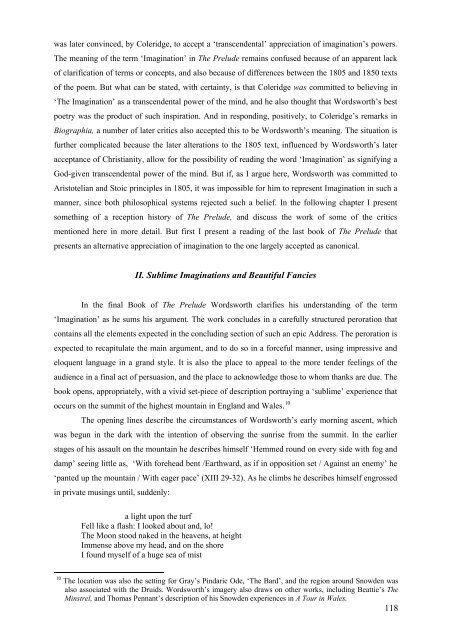Contents - ResearchSpace@Auckland - The University of Auckland
Contents - ResearchSpace@Auckland - The University of Auckland
Contents - ResearchSpace@Auckland - The University of Auckland
You also want an ePaper? Increase the reach of your titles
YUMPU automatically turns print PDFs into web optimized ePapers that Google loves.
was later convinced, by Coleridge, to accept a ‘transcendental’ appreciation <strong>of</strong> imagination’s powers.<strong>The</strong> meaning <strong>of</strong> the term ‘Imagination’ in <strong>The</strong> Prelude remains confused because <strong>of</strong> an apparent lack<strong>of</strong> clarification <strong>of</strong> terms or concepts, and also because <strong>of</strong> differences between the 1805 and 1850 texts<strong>of</strong> the poem. But what can be stated, with certainty, is that Coleridge was committed to believing in‘<strong>The</strong> Imagination’ as a transcendental power <strong>of</strong> the mind, and he also thought that Wordsworth’s bestpoetry was the product <strong>of</strong> such inspiration. And in responding, positively, to Coleridge’s remarks inBiographia, a number <strong>of</strong> later critics also accepted this to be Wordsworth’s meaning. <strong>The</strong> situation isfurther complicated because the later alterations to the 1805 text, influenced by Wordsworth’s lateracceptance <strong>of</strong> Christianity, allow for the possibility <strong>of</strong> reading the word ‘Imagination’ as signifying aGod-given transcendental power <strong>of</strong> the mind. But if, as I argue here, Wordsworth was committed toAristotelian and Stoic principles in 1805, it was impossible for him to represent Imagination in such amanner, since both philosophical systems rejected such a belief. In the following chapter I presentsomething <strong>of</strong> a reception history <strong>of</strong> <strong>The</strong> Prelude, and discuss the work <strong>of</strong> some <strong>of</strong> the criticsmentioned here in more detail. But first I present a reading <strong>of</strong> the last book <strong>of</strong> <strong>The</strong> Prelude thatpresents an alternative appreciation <strong>of</strong> imagination to the one largely accepted as canonical.II. Sublime Imaginations and Beautiful FanciesIn the final Book <strong>of</strong> <strong>The</strong> Prelude Wordsworth clarifies his understanding <strong>of</strong> the term‘Imagination’ as he sums his argument. <strong>The</strong> work concludes in a carefully structured peroration thatcontains all the elements expected in the concluding section <strong>of</strong> such an epic Address. <strong>The</strong> peroration isexpected to recapitulate the main argument, and to do so in a forceful manner, using impressive andeloquent language in a grand style. It is also the place to appeal to the more tender feelings <strong>of</strong> theaudience in a final act <strong>of</strong> persuasion, and the place to acknowledge those to whom thanks are due. <strong>The</strong>book opens, appropriately, with a vivid set-piece <strong>of</strong> description portraying a ‘sublime’ experience thatoccurs on the summit <strong>of</strong> the highest mountain in England and Wales. 10<strong>The</strong> opening lines describe the circumstances <strong>of</strong> Wordsworth’s early morning ascent, whichwas begun in the dark with the intention <strong>of</strong> observing the sunrise from the summit. In the earlierstages <strong>of</strong> his assault on the mountain he describes himself ‘Hemmed round on every side with fog anddamp’ seeing little as, ‘With forehead bent /Earthward, as if in opposition set / Against an enemy’ he‘panted up the mountain / With eager pace’ (XIII 29-32). As he climbs he describes himself engrossedin private musings until, suddenly:a light upon the turfFell like a flash: I looked about and, lo!<strong>The</strong> Moon stood naked in the heavens, at heightImmense above my head, and on the shoreI found myself <strong>of</strong> a huge sea <strong>of</strong> mist10 <strong>The</strong> location was also the setting for Gray’s Pindaric Ode, ‘<strong>The</strong> Bard’, and the region around Snowden wasalso associated with the Druids. Wordsworth’s imagery also draws on other works, including Beattie’s <strong>The</strong>Minstrel, and Thomas Pennant’s description <strong>of</strong> his Snowden experiences in A Tour in Wales.118














